WORLD CLASS COACHING
Build Up From the Back - Exercises 1
By Luca Bertolini
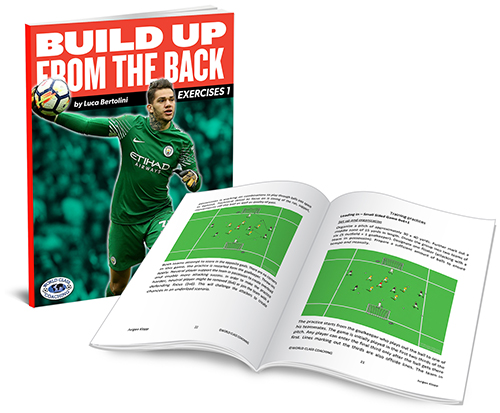
Table of Contents
PART TWO
Distribution Along the Flanks
Distribution Along the Flanks
The creation of numerical advantage on the flanks or how to manage a duel with equal numbers of players are the main objectives for a team to progress forward on the flanks. If there is enough space for a through pass between the air-bodies, the center balance player can receive behind them to progress forward; but if it's not possible, he must drop back to create a 3 v 2 duel to overcome the opposition pressure.
The players involved in these exercises are the goalkeeper, the center back, the fullback and the center balance midfielder; the goalkeeper must always have a free wide passing option to distribute, when the opposition forwards try to force the direction of play toward the sidelines.
The positions of the fullbacks are key points to play out from the back, as they often have to face front 1 v 1 duels and the success of this phase of play depends on their duels or their skills to combine with teammates at speed.
The player technical skills, with good speed and both the feet, must be the tools to coach in these situations. These technical skills must be practiced in the correct positions, with reminders of the right direction of further passes, wide and deep movements, opposition pressure, and position in relation to teammates and opponents.
The fullback must be able to help the creation of numerical advantage inside a strong area or a strong side, as well as to push forward when he's placed along a weak side of the opposition, after a switch of play.
They have to know how to push up in the midfield, how to cut past the opposition, how to take the right choices to build up in order to play out, as they have to overcome the opposition pressure and they must be able to face different styles of defensive play and opposition pressure.
The center backs must always have the vision of the field to organize this phase of play, they must be always a support for the fullbacks, or they must be able to shift toward wide positions when the fullbacks run forward or toward the center in the middle third.
The center balance player must be free to be a target player. He must call for the ball at the right time and with the correctly angled posture as well as create space dropping back to receive; he must ready to receive from the fullbacks and to combine with them to break through the opposition pressure.
If the pressing forwards are three, the second center back is involved in the sequences to create 4 v 3 duels to progress up the pitch and the center balance player must always drop back, either to receive the ball and support the move, and to provide the coverage of the space, when the center back shifts across to the right or the left sidelines.
Exercise 14: distribution along the flanks against two opponents
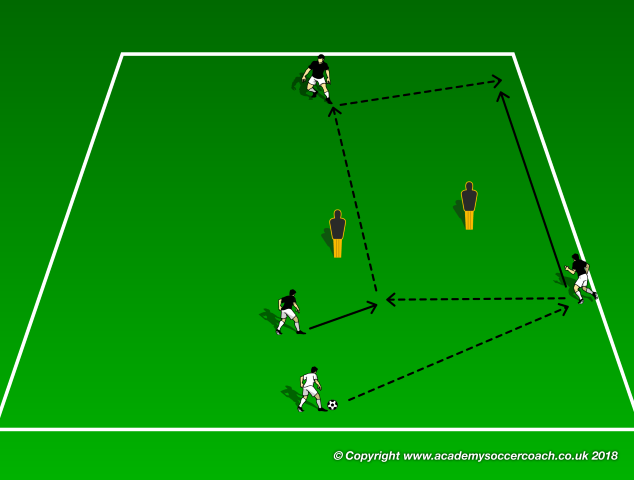
Set-up and Sequence: one goalkeeper and three players are placed wide inside a rectangular or square area; two air-bodies are placed along one side to simulate two pressing forwards. The goalkeeper is in possession and when he sends a sign, the center back shifts across the side of play (right or left) and the fullback receives; the sequence is carried out on the right in the picture. The fullback passes inside to the center back, who then plays forward to the balance player, breaking through the line between the air-bodies (pressing forward). The fullback receives on his run and wide. The sequence ends:
• with a back pass to the goalkeeper
• with a wall passing combinations with the center balance player
• with a back pass to the center back who move away toward the free side to lose the air-body
The players rotate their positions clockwise or counterclockwise.
Eye on: play 1 touch passing combination to overcome the air-bodies line, run forward to receive with the right timing, play as third man on the flank.
Exercise 15: distribution along the flanks against two opponents
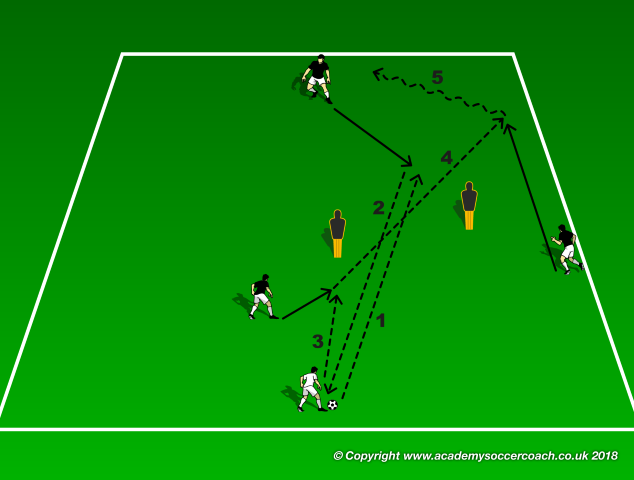
Set-up and Sequence: one goalkeeper and three players are placed wide inside a rectangular or square area; two air-bodies are placed along one side to simulate two pressing forwards. The goalkeeper is in possession and when he sends a sign, the center back shifts across the side of play; the sequence is carried out on the right in the picture. The goalkeeper plays a wall passing combination with the center balance player who drops back behind the air-bodies to be an option; as the back pass is received, the center back passes forward and between the air-bodies to cut them out, on the run of the fullbacks, who receives and dribbles the ball up. The sequence ends:
• with a back pass to the goalkeeper
• with a wall passing combinations with the center balance player
• with a back pass to the center back who move away toward the free side to lose the air-body
The players rotate their positions clockwise or counterclockwise.
Eye on: play 1 touch passing combination to overcome the air-bodies line, run forward to receive with the right timing, play as third man on the flank.
Exercise 15: distribution along the flanks against two opponents
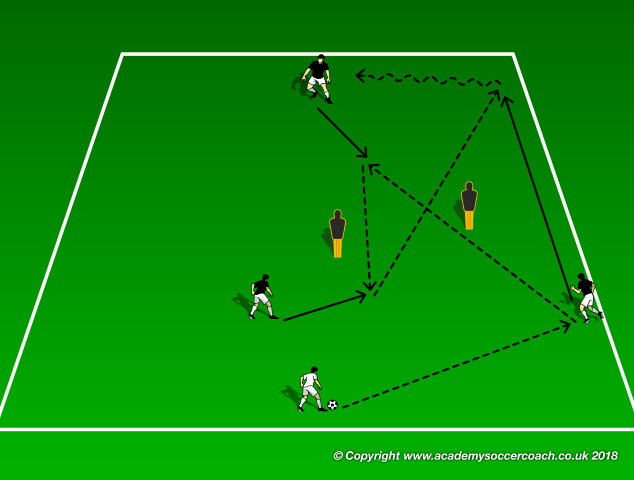
Set-up and Sequence: one goalkeeper and three players are placed wide inside a rectangular or square area; two air-bodies are placed along one side to simulate two pressing forwards. The goalkeeper is in possession and when he sends a sign, the center back shifts across the side of play; the sequence is carried out on the right in the picture. The goalkeeper passes to the fullback who plays forward with one touch toward the center balance player while he's dropping back behind the air-bodies to be an option. As the balance player receives, he passes back between the air-bodies again to the center back, who plays a one touch forward pass on the run of the fullback, who receives behind the air-body cutting the line of pressure and he then dribbles the ball toward the center space. The sequence ends:
• with a back pass to the goalkeeper
• with a wall passing combinations with the center balance player
• with a back pass to the center back who move away toward the free side to lose the air-body
The players rotate their positions clockwise or counterclockwise.
Eye on: play 1 touch passing combination to overcome the air-bodies line, run forward to receive with the right timing, play as third man on the flank.
Exercise 16: distribution along the flanks against two opponents
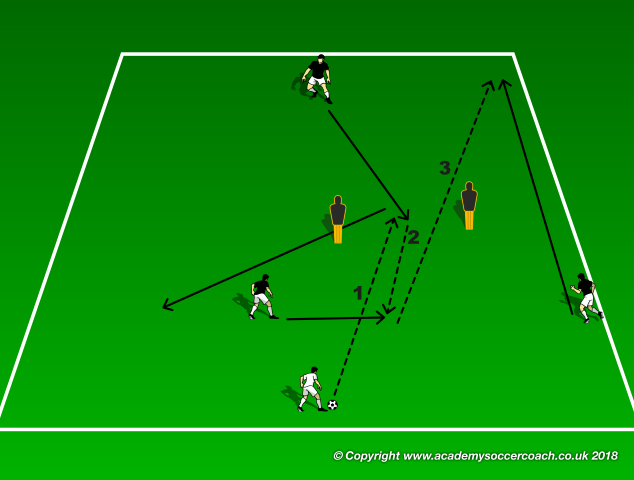
Set-up and Sequence: one goalkeeper and three players are placed wide inside a rectangular or square area; two air-bodies are placed along one side to simulate two pressing forwards. The goalkeeper is in possession and when he sends a sign, the center back shifts across the side of play; the sequence is carried out on the right in the picture. The goalkeeper plays a wall passing combination with the center balance player while he's dropping back in behind the air-bodies to be an option. As the back receives, he passes forward again on the run of the fullback, who receives behind the air-body, cutting the line of pressure. The center player moves then wide to receive a potential back pass to save the possession. The sequence ends:
• with a back pass to the goalkeeper
• with a wall passing combinations with the center balance player
• with a back pass to the center back who move away toward the free side to lose the air-body
The players rotate their positions clockwise or counterclockwise.
Eye on: timing of dropping back run and wall passing combination, play 1 touch combinations to overcome the air-bodies line, run forward to receive with the right timing, play as third man on the flank.
Exercise 17: distribution, switching the side, along the flanks against three opponents
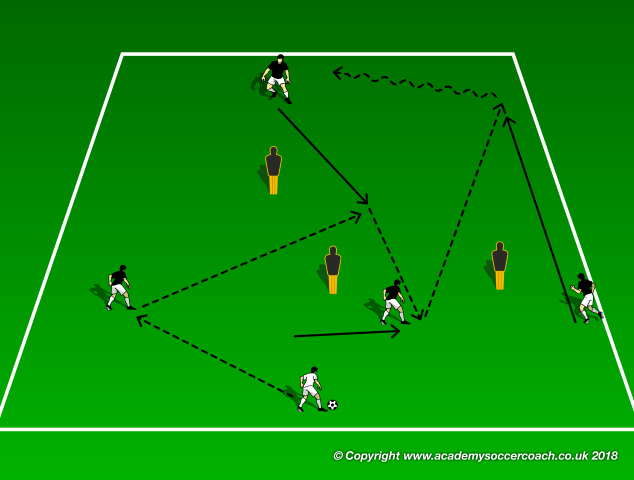
Set-up and Sequence: one goalkeeper and four players are placed inside a rectangular or square area; three air-bodies are placed in the middle to simulate three pressing forwards (1-2). The goalkeeper is in possession and when he sends a sign, the center back of the flank where the combination has to be carried out shifts across, while the goalkeeper passes the ball to the opposite center back. The receiver passes the ball to the dropping back forward center balance player, anticipating the first air-body; he receives and passes back to the second center back who then plays forward on the run of the fullback who receives the ball behind the air-bodies to simulate the break through of a pressure line. The fullback dribbles toward the center space. The sequence ends:
• with a passing combination to move the ball back and play out again
• with a direct pass to the center back or the goalkeeper
The players rotate their positions clockwise or counterclockwise.
Eye on: timing of run to link the movements, play diagonal 1 touch passing combination to break the pressure line, drop back with the right timing, and work on different lines.
Exercise 18: distribution, switching the side, along the flanks against three opponents
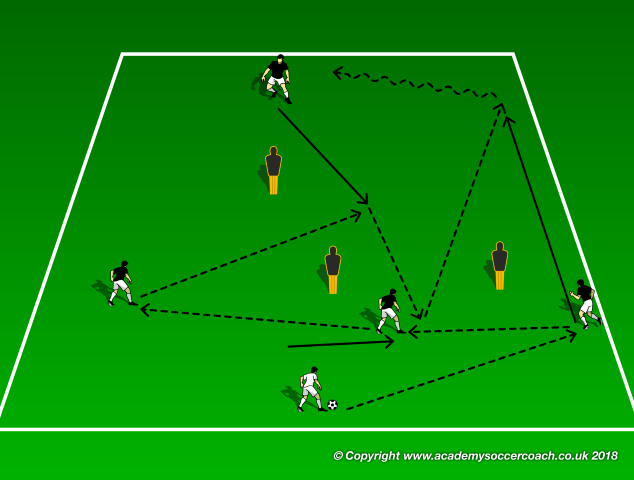
Set-up and Sequence: one goalkeeper and four players are placed inside a rectangular or square area; three air-bodies are placed in the middle to simulate three pressing forwards (1-2). The goalkeeper is in possession and when he sends a sign, the center back of the flank where the combination has to be carried out shifts across, while the goalkeeper passes the ball to the fullback. The receiver passes the ball inside to the nearest center back and again toward the second center back; the forward center balance player now must drops back to receive, anticipating the first air body. Then he passes back to the first center back. The player now in possession plays forward on the run of the fullback who receives the ball behind the air-bodies to simulate the break through of a pressure line. The fullback dribbles toward the center space. The sequence ends:
• with a passing combination to move the ball back and play out again
• with a direct pass to the center back or the goalkeeper
The players rotate their positions clockwise or counterclockwise.
Eye on: timing of run to link the movements, play diagonal 1 touch passing combination to break the pressure line, drop back with the right timing, and work on different lines.
Exercise 19: distribution, switching the side, along the flanks against three opponents
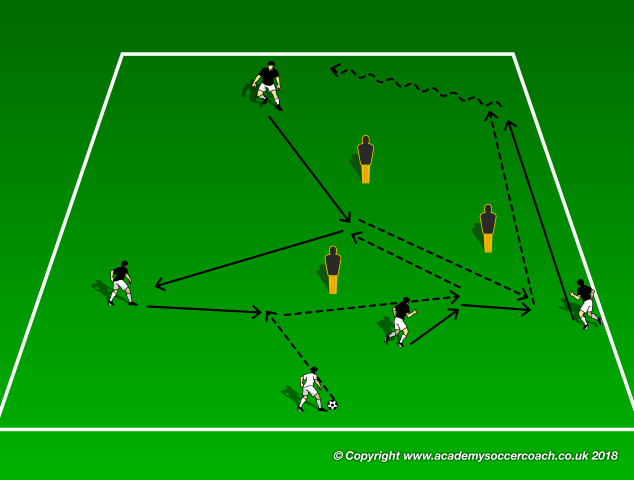
Set-up and Sequence: one goalkeeper and four players are placed inside a rectangular or square area; three air-bodies are placed in the middle to simulate three pressing forwards (1-2). The goalkeeper is in possession and when he sends a sign, the center backs shift across the flank where the combination has to be carried, while the goalkeeper passes the ball to second incoming player. The receiver passes to the further teammate toward the right and he plays a wall passing combination with the dropping back center balance player, before passing forward on the run of the fullback. The fullback receives the ball behind the air-bodies to simulate the break through of a pressure line and he dribbles toward the center space. The sequence ends:
• with a passing combination to move the ball back and play out again
• with a direct pass to the center back or the goalkeeper
The players rotate their positions clockwise or counterclockwise, depending on the side of movement.
Eye on: timing of run to link the movements, play diagonal 1 touch passing combination to break the pressure line, drop back with the right timing, and work on different lines.
Exercise 20: distribution, switching the side, along the flanks against three opponents
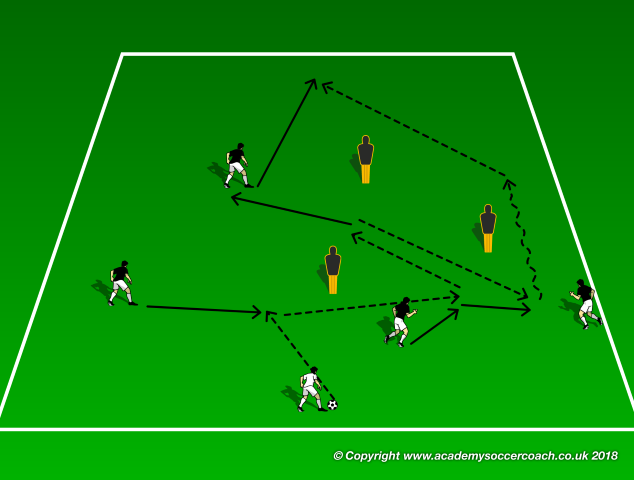
Set-up and Sequence: one goalkeeper and four players are placed inside a rectangular or square area; three air-bodies are placed in the middle to simulate three pressing forwards (1-2). The goalkeeper is in possession and when he sends a sign, the center backs shift across the flank where the combination has to be carried, while the goalkeeper passes the ball to second incoming player. The receiver passes to the further teammate toward the right and he plays forward to the dropping back center balance player. The fullback receives the ball and dribbles the ball over the first two lines of the air-bodies to simulate the break through of a pressure line and he passes over the last air-body, where the balance player receives to overcome the last pressure line. The sequence ends:
• with a passing combination to move the ball back and play out again
• with a direct pass to the center back or the goalkeeper
The players rotate their positions clockwise or counterclockwise, depending on the side of movement.
Eye on: timing of run to link the movements, play diagonal 1 touch passing combination to break the pressure line, drop back with the right timing, and work on different lines.


